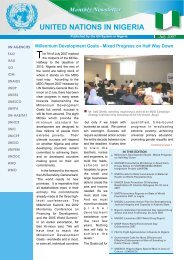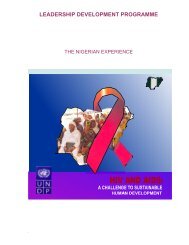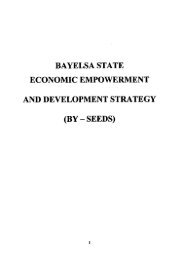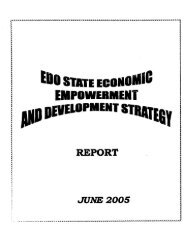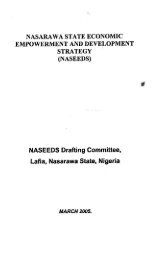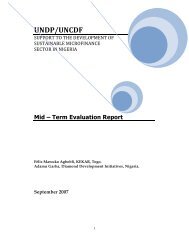Niger Delta Human Development Report - UNDP Nigeria - United ...
Niger Delta Human Development Report - UNDP Nigeria - United ...
Niger Delta Human Development Report - UNDP Nigeria - United ...
Create successful ePaper yourself
Turn your PDF publications into a flip-book with our unique Google optimized e-Paper software.
Map 1.1: States and Local Governments of the <strong>Niger</strong> <strong>Delta</strong><br />
The freshwater swamp zone is<br />
characterized by seasonal flooding. It is<br />
during the rainy season that its swampy<br />
characteristics are vividly obvious. It has<br />
the most distinct subdivisions, is most<br />
diverse in terms of biology and supports a<br />
similar ecology to the one in the coastal<br />
barrier islands. The zone's three<br />
subdivisions are the flood forest zone or<br />
'upper delta', the marsh forest zone and<br />
the eastern flank. The flood forest<br />
subdivision has large sand river channels,<br />
permanent creeks and seasonal flood<br />
creeks, and is inundated annually by the<br />
<strong>Niger</strong> River flood. Flood-free levees are<br />
common, while back swamps and cane<br />
forests help give the zone a highly diverse<br />
habitat. The marsh forest subdivision is also<br />
referred to as the transition zone. It is<br />
permanently swampy and under flooding<br />
from freshwater. Muddy swamp channels<br />
and raffia swamps can be found in the zone,<br />
and its species of wildlife are usually<br />
different from those of the flood forest<br />
zone. The eastern flank is thought to have<br />
been a flood forest when the Orashi River<br />
was a major tributary of the <strong>Niger</strong> <strong>Delta</strong><br />
(Powell 1995).<br />
The lowland rainforest zone is in the<br />
northern part of the <strong>Niger</strong> <strong>Delta</strong> region,<br />
beyond the areas of dense river and creek<br />
networks. It is not considered within the<br />
area defined by the natural limits of the<br />
<strong>Niger</strong> <strong>Delta</strong>, but falls within the broader<br />
<strong>Niger</strong> <strong>Delta</strong> area. This is the least swampy<br />
part of the region. It has a varied geology<br />
and terrain, but sedimentary rock<br />
formations, mostly sandstone with some<br />
shale and limestone, underlie most areas.<br />
The rock formations present a ridge and<br />
valley topography. In some areas of Akwa<br />
Ibom, Cross River and Ondo states, the<br />
terrain is characterized by advanced gully<br />
erosion. In Edo, Cross River and Ondo<br />
states, there are areas of old, crystalline<br />
basement complex rocks, mainly granites,<br />
gneisses and granodiorite. These areas are<br />
characterized by rugged, rocky terrain with<br />
massive rock domes and inselbergs.<br />
Apart from the <strong>Niger</strong> River, the other<br />
major rivers in the region include the Cross,<br />
Imo, Qua Iboe and Orashi in the east; and<br />
the Benin, Oluwa and Siluko in the West.<br />
Climate<br />
The <strong>Niger</strong> <strong>Delta</strong> has a semi-hot, humid<br />
equatorial climate with wide variations from<br />
one part of the region to another. This is a<br />
place of uniformly high temperatures<br />
throughout the year, high relative humidity<br />
and intense rainfall, which occurs almost<br />
year round in the core delta, but becomes<br />
markedly seasonal further inland with<br />
increasing distance from the ocean. Copious<br />
rainfall coupled with the low relief and high<br />
water table produce frequent flooding (see<br />
box 1.7).<br />
20 NIGER DELTA HUMAN DEVELOPMENT REPORT



